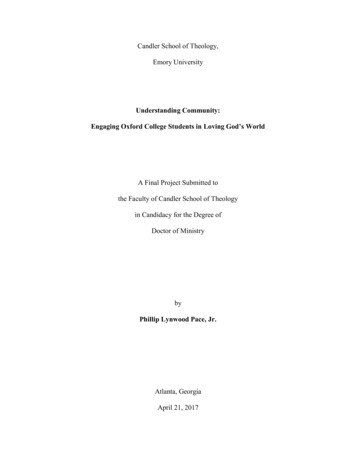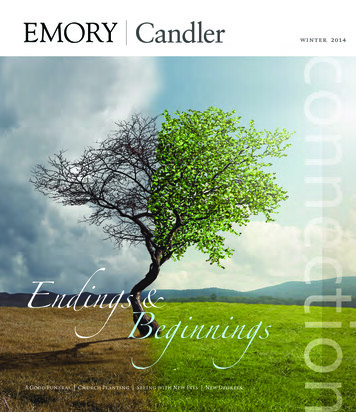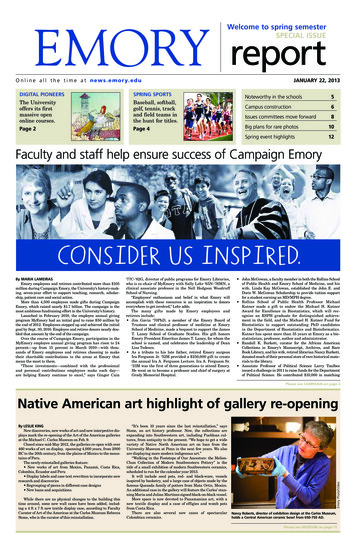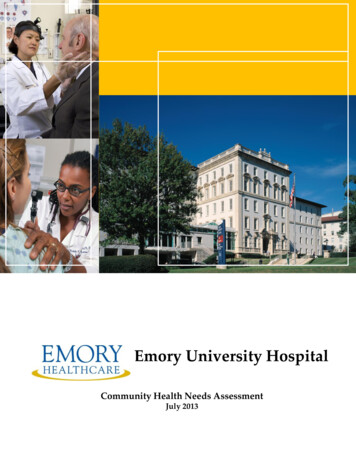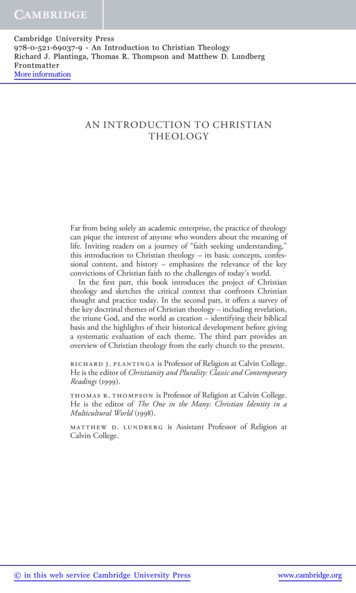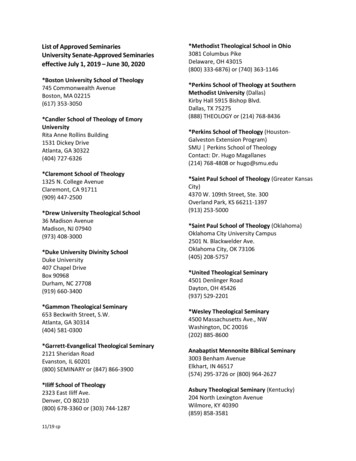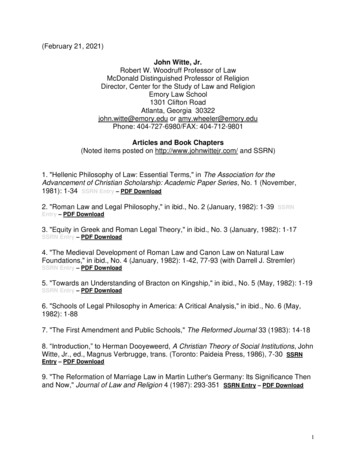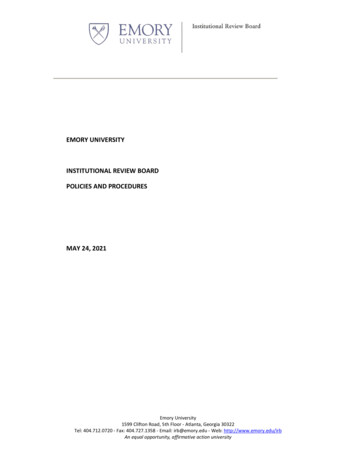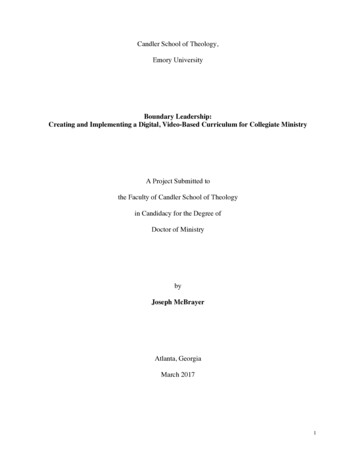
Transcription
Candler School of Theology,Emory UniversityBoundary Leadership:Creating and Implementing a Digital, Video-Based Curriculum for Collegiate MinistryA Project Submitted tothe Faculty of Candler School of Theologyin Candidacy for the Degree ofDoctor of MinistrybyJoseph McBrayerAtlanta, GeorgiaMarch 20171
IntroductionThe past six semesters of our Doctor of Ministry course work and research, including buildingrelationships and asset mapping the Emory University community, have deeply shaped the author’sview of community formation and learning about how people find and create belonging in community.Structural and social analysis research into the challenges and opportunities in the Emory Universitycommunity have further demonstrated the importance of remarkable and adaptive people in leadershippositions both in institutional and community settings. Author and researcher Gary Gunderson calls this“Boundary Leadership,” which “is the practice of leadership in the boundary zone, the space inbetween settled zones of authority, where relationships are more fluid, dynamic, and itinerant.”1 AtEmory, boundary leaders are seen in many places and play a critical role in helping marginalizedstudents to find belonging, build community and connections, make meaning, learn resiliency, andhave a lasting, sustainable impact in both the Emory community and the communities in whichthey find themselves after their time at Emory.Boundary Leadership is necessary in order to build vibrant, thriving communities ofinclusion, wholeness, and mutual prosperity, which, for Christians, exemplifies the in-breakingKingdom of God made manifest through our loving actions. Boundary Leaders work intentionally inand between fluid communities to connect people to institutions, associations, and movements in whichall community members can live out their passions, abilities, and embodied practices that confront andtransform systemic injustice, despair, and isolation for the health and good of the whole community.2Boundary Leaders must make intentional choices to live amongst and between boundaries of race,ethnicity, socio-economic, age, sexuality, language, and culture in order to address issues of systemic,institutional bias, raise social-consciousness, create spaces of belonging and community, and help1Gary R. Gunderson and James R. Cochrane, Religion and the Health of the Public (New York: Palgrave Macmillan,2012), Kindle edition, 119-120.2Gunderson, Religion and the Health of the Public, 121: most especially the “not yet” potential of a community.2
empower and equip other people as leaders as well. Boundary Leaders must be competent in a varietyof “languages” and cultures, confident in their own self-differentiation as persons, and willing to riskand cross over traditional boundary lines in service of the whole of the community. Learning the theoryand practice of Boundary Leadership does not begin with global icons, but through interaction with andcareful observation of the pattern of the lives of people in our communities who do communityorganizing, community development, and facilitate places and structures of belonging for everydaypeople.3The goals of this project were to learn and more deeply understand how boundary leadersfunction on the Emory University campus, to further the author’s understanding of boundary leadershipin ministry, and to create a media rich, digital, video-based curriculum on boundary leadership to beused with a pilot group of college students. In this process the author was able to document and learnhow boundary leaders are formed and how ministers can increase their capacity and skills for boundaryleadership. The video interviews of eight existing and emerging boundary leaders in the EmoryUniversity community facilitated the capture of detailed information about how they function in theircommunity work, take care of themselves, see the world around them, and perceive their work andthemselves as leaders in the various communities in which they participate. Collecting this informationconfirmed the author’s previous research and discovery of boundary leaders on campus while alsopushing his understanding of boundary leadership, increasing his skills at video and camera work indigital storytelling, and teaching the author a great deal about digital curriculum creation.4Ultimately, this project’s aim was to create a visually based curriculum to help educate and createother boundary leaders while confirming and expanding the author’s perceptions of the vital importance3Gunderson, Religion and the Health of the Public, 128.Much of this early ethnographic work was deeply informed and shaped by two sources: Mary McClintockFulkerson, Places of Redemption: Theology for a Worldly Church (Oxford: Oxford University Press, 2007), KindleEdition, and Mary Clark Moschella, Ethnography as a Pastoral Practice An Introduction. (Cleveland, Ohio: ThePilgrim Press, 2008). The curriculum was used with a three-week pilot group to test out both the content and format.43
of boundary leadership in community formation, social action and positive systemic change, and thegreat opportunity for boundary leadership in our communities on campus and beyond. The creation ofthis media rich, digital, video-based curriculum on boundary leadership was itself a practice ofboundary leadership across different disciplines and communities, which led the author to become abetter boundary leader and to make further connections of the theories and texts of boundary leadershipwith the realities and observations of the opportunities awaiting boundary leaders in community.Part I: Boundary LeadershipThe term “boundary leadership” comes from author and public health worker GaryGunderson’s years of work, observation, and research into the leading causes of life andcommunity formation in places from Atlanta to Africa, from rural to urban, and from the streets tohigh-steeple congregations. In his time amongst this diversity of communities he noticed theprevalence of a specific kind of leader who was able to work in and around the margins, spaces,and intersections of institutional and communal boundaries. Not only was this kind of leader ableto cross over these boundaries to bring about community positive changes and outcomes, but alsohe or she was able to do so without completely burning out or being run out of town. He calls thiskind of leader a “boundary leader,” which is both a descriptive and an aspirational naming: onewho leads well and who is able to cross these typical boundaries.5 Gunderson writes, “The work ofboundary leaders is to align the assets of community with the most relevant science and mostmature faith.”6 This asset-based community development strategy is a systems-level and yet onthe-ground way of thinking while moving in and between communities, organizations, andstructures. Boundary leaders exist in and around the places where boundary zones bump up5Gary R. Gunderson, Boundary Leaders: Leadership Skills for People of Faith (Minneapolis: Fortress Press, 2004),Kindle edition, location 107.6Ibid., locations 112-113.4
against one another. Gunderson writes, “Boundaries are where things come together, where thefields of relationship engage. A boundary is exactly not where things separate, but the edge ofwhere things join: physically, as between nations; legally, as between organizations; emotionally,as between values; mentally, as between ideas.”7 This space between is a location where change isthe only constant and where boundary leaders’ unique skills and adaptations are absolutelyessential. Boundary leadership “ignores the lines and moves over, into, beyond, across, amongvital emergent zones” and “gives priority to the expansive, endless, and open against the insular,interior, parochial, and delimited.”8Gunderson notes that boundary leaders have specific strengths and characteristics: a broadweb of relationships, resiliency, imagination, a capacity to see “patterns of possibility,” and great“organizational intelligence.”9 Boundary leaders are uniquely adapted to the margins, edges, andspaces between—they see these change-centered conditions as powerful opportunities to fostermeaningful change in communities.10 In Common Fire, an intriguing analysis of leaders who workdiligently for the common good, the authors write that “there are two kinds of marginality; one isbased on vulnerability, the other reflects distinctive values that place one apart from the center ofthe culture.”11 Many boundary leaders belong to the latter and, through their life experiences, arecomfortable at the margins and edges of groups because they take on the “call to a constructive,enlarging engagement with the other.”12 The vulnerability-based marginality experienced by manyboundary leaders is not a choice, but rather demonstrates their ability to transform the pain ofexclusion and marginality “into a deepened capacity for compassion and a strength of identity and7Gunderson, Boundary Leaders, locations 133-134.Ibid., locations 162-167.9Ibid., location 927.10Ibid., location 923.11Laurent A. Parks Daloz, Cheryl H. Keen, James P. Keen, and Sharon Daloz Parks, Common Fire (Boston: Beacon,1996), 3.12Ibid., 3.85
purpose.”13 Gunderson finds that “boundary leaders emerge because the very force of life drawsthem out and up toward the vital arenas where the future is trying to be born” and it is this drive,this calling, this ability to see things differently, which guides them in navigating the edges andspaces between groups, people, ideas, and institutions.14 Boundary leaders enjoy and thrive in themargins because they see the boundaries as places where differences flourish and they perceive theimmense potential for building “bridges of understanding involving race, wealth, gender,profession, academics, age, and faith.”15Authors Preskill and Brookfield write in Learning as a Way of Leading, that “leadershipitself is a normative practice focused on the project of increasing people’s capacity to be activeparticipants in the life of their communities, movements, and organizations” and that “the purposeof leadership is to sustain the desire of people to go on contributing, as both leaders and followers,to everyone’s overall benefit.”16 Their writing draws on the lessons from the struggle for justice ofthe 20th century and highlights leadership practices that support the growth of others: “listening,staying curious about others, asking constructive questions, learning the stories of co-workers, andchampioning follower goals.”17 These leadership practices that support the growth of others arewell suited for the interview-based work of this project and boundary leadership in general.Preskill and Brookfield astutely note that the key aspects of leadership are “discovering people’spassions” and finding ways for them to use their passions to help better the world.18 Author PeterBlock notes that common ideas or goals draw people together into voluntary associations where a13Daloz, Common Fire, 73.Gunderson, Boundary Leaders, location 918.15Ibid., location 952.16Stephen Preskill and Stephen D. Brookfield, Learning as a Way of Leading: Lessons from the Struggle for SocialJustice (San Francisco: Wiley, 2009), 61.17Ibid., 62.18Ibid., 65.146
sense of “belonging” is created.19 This sense of belonging and interconnectedness can be observedin group dynamics, leadership styles, and even the physical layout of rooms and meeting spaces.20These observations on hospitality and awareness played an important role in conducting theinterviews and in creating a welcoming space for the pilot group sessions. The pilot group was ofprimary importance in this project as the proving ground and main instrument of determining theeffectiveness of the curriculum. Block wisely notes, “The small group is the unit of transformationand container for the experience of belonging” and this sense of belonging was must not be for itsown sake, but rather for the transformation of the larger community.21 Block’s principles of smallgroup work, spatial and meeting space analysis, and leadership dynamics offer concrete andpractical applications of boundary leadership in community.Observed Characteristics and Strengths of Boundary LeadersIn conducting interviews of practicing and emerging boundary leaders, it was clear thatGunderson’s theories and observations of boundary leadership held true. In both the formal, studiointerviews and walking across campus with the interviewees it was clear that each possessed thecore strengths of boundary leadership: a broad web of relationships, resiliency, imagination, acapacity to see “patterns of possibility,” and great “organizational intelligence.”22 Intervieweespossessed varying degrees of these strengths, which was especially visible in comparing theemerging boundary leaders and the more experienced boundary leaders.The depth of their webs of relationships was most clearly visible during the interviews asthey walked around campus with the author to capture background footage. During the walks,19Peter Block, Community: the Structure of Belonging (Oakland: Berrett-Koekler, 2009), 13-14.Ibid., 145-149.21Ibid., 29.22Gunderson, Boundary Leaders, location 927.207
each interviewee saw several people he or she knew, waved to, greeted, and/or with whom theyeven stopped to talk—all while being filmed with significant camera equipment present, which isusually a deterrent.23 This trait was even more clearly observed when walking with the moreexperienced boundary leaders. Author and peace-builder John Paul Lederach writes that “thecenter of building sustainable justice and peace is the quality and nature of people’s relationships”and that “a key to constructive social change lies in that which makes social fabric, relationships,and relational spaces.”24 Each of the interviewees shared about the value and importance ofrelationships in their work in the Emory community with one saying, “Relationships arefoundational to everything that I do—we can’t do any of this work on our own”25 and anothernoting that “Networks [of relationships] are really life webs and without them we’re notsustainable.”26 Another interviewee remarked, “Relationships are how I make sense of the world—it feels very organic and almost like breathing to get to know people. It’s hard for me to pictureliving without relationships being central to how I move.”27Another key strength of boundary leaders is resiliency: the ability “to withstand or recoverquickly from difficult conditions.”28 Gunderson notes that boundary leaders are resilient “becausethey have high tolerance for ambiguity and excellent survival skills” and, while they do perceivethe brokenness in and amongst the boundary zones, they “are not defeated by either the powerfulinterests that create the pain or by the divisions that threaten to obstruct progress.”29 All of the23The author has known many of the interviewees for several years and has even walked with many around campuspreviously, but not until filming and interviewing these leaders had the author witnessed such a visible and tangiblesign of their webs of connectedness and relationships.24John Paul Lederach, The Moral Imagination: The Art and Soul of Building Peace (New York: Oxford UniversityPress, 2005), Kindle edition, page 76.25Danielle Bruce Steele, interview by author, December 2016.26Dr. Bobbi Patterson, interview by author, December 2016.27Ruth Ubaldo, interview by author, December 2016.28The New Oxford American Dictionary (New York: Oxford University Press, 2010), Kindle edition, location 701327.29Gunderson, Boundary Leaders, locations 1032-1035.8
interviewees demonstrated some level of resiliency—however, those with more life experiencesand deeper self-knowledge tended to possess an even deeper sense of what it takes to be resilientand how to cultivate resiliency in those with whom they work. They possessed a deep sense ofhow their own resiliency added to the resilience of the wider community.30 Many of these leaderspossess unique skills as a result of their challenging life experiences and Gunderson notes thatthese “wounds” and difficult experiences of the individual are qualifications for communityministry in that they allow the community to know how to care for people going through thosevery life experiences and difficulties.31 When individuals engage in practices of self-reflection andthe process of knowing themselves, what author, Rabbi, and psychologist Edwin Friedman called“self-differentiation,” they are able to be better decision makers, connectors, and boundaryleaders.32 The interviewees possessed a high level of self-knowledge through their own lifeexperiences and an intentional “commitment to the lifetime project of being willing to becontinually transformed by one’s experience.”33 One interviewee remarked, “Resiliency is reallyabout coming to the conclusion that you are worth fighting for more than once” and that your ownperson –your very self—is worth your own attention and intentional time spent in self-care.34Devotional author Richard Foster writes that “the most difficult problem is not finding the time,but convincing myself that this is important enough to set aside the time.”35 Creating a habit ofself-care appears to be a necessity for boundary leadership that lasts.36All of the interviewees shared that they engage in intentional daily or weekly times for30Gunderson, Boundary Leaders, location 1039.Ibid., location 1059.32“Self differentiation” in Edwin H. Friedman, A Failure of Nerve: Leadership in the Age of the Quick Fix, ed.Margaret M. Treadwell, Edward W. Beal (New York: Church Publishing, Inc., 2007), Kindle edition, locations 346348.33Ibid., locations 447-448.34Carlton Mackey, interview by author, December 2016.35Richard J. Foster, Celebration of Discipline: the Path to Spiritual Growth (New York: Harper Collins, 1998), 70.36James K. A. Smith, You Are What You Love, (Grand Rapids: Brazos Press, 2016), 6, 21.319
reflection, contemplation, rest, and self-care—ranging from practices like walking or running as aphysical exercise and a way to clear the mind/body, to morning and evening meditation, to artisticexpression through painting, music, or poetry.37 These practices foster a deeper sense of self,create opportunities for critical reflection, and build capacity for resiliency amidst the expecteduncertainty of leadership at the margins.Gunderson’s observations of boundary leaders show that they “have strength of imagination,a subtle capacity to see what could be.”38 This capacity for imagination allows boundary leaders tosee things differently than many people: where most see challenges or problems to be “fixed”—boundary leaders see the assets, gifts, and opportunities in each person, place, and community.They are not unrealistic about the needs of a community nor use some false sense of individualimagination as a way to optimistically hide away from the challenges and wounds in a community,but rather they use their community-centric, imaginative, socially-interconnected creativity toperceive what might be in a community.39 The boundary leaders interviewed in this projectdemonstrated remarkable ways of seeing and engaging with their communities. Many intervieweespossessed ways of seeing that were simultaneously realistic and creative—stemming from boththeir individual and communal life experiences and the broadness of their relationships. As withGunderson’s observations, the author found that the interviewee’s practices of imagination andseeing were grounded in their webs of relationships and their resiliency, which flow from properreflection and self-assessment and facilitates their capacity for imaginative thinking.40 In the everchanging boundary zones “Imagination is what makes it possible for webs of transformation37Kevin McIntosh, Dr. Elizabeth Corrie, Ruth Ubaldo, Dr. Bobbi Patterson, Carlton Mackey, Rashika Verma, andDanielle Bruce Steele, interviews by author, December 2016. Rev. Lyn Pace, interview by author, November 2016.38Gunderson, Boundary Leaders, locations 1083-1084.39Ibid., location 1089.40Ibid., location 1087.10
formation to emerge out of chaos.”41It is in these webs of relationship and transformation that boundary leaders demonstrate theirskill at recognizing “patterns of possibility” and their capacity to hold in tension the realities ofcommunities and individuals with the potential of what might be. Gunderson finds that boundaryleaders “act as midwives to the imagination, listening, reflecting, and looking carefully forpatterns and people and power.”42 Boundary leaders are able to see and understand the worldaround them in ways that help them to recognize patterns in the systemic structures and know howto live, survive, and even thrive on the margins. Institutions and groups bumping up against oneanother— metaphorically and even sometimes literally— can at least in part cause the chaoticconditions found at the boundary zones. These interactions can most easily be seen and navigatedthrough deep webs of relationship, which help us to visualize and understand from an individuallevel to the systemic. This systems-level perspective allows boundary leaders to have“organizational intelligence” and the ability to navigate complex situations with the powers thatbe.43 The boundary leaders interviewed in this project also know how to “dance” with theinstitutional forces to keep the “lights on” and grant money coming in for their programs, areas,and projects. And, despite their many relationships, obligations, time commitments, and officialbusiness necessary in their positions, these boundary leaders maintain an unshakable focus on theimportance of the people, the stories, and the communities in which they live, move, and work.Surprises from the InterviewsThe information gathered in the interviews yielded only small differences to Gunderson’stheories and observations of boundary leadership. This was not too surprising given that his41Gunderson, Boundary Leaders, locations 1086-1087.Ibid., location 1090.43Ibid., location 1159.4211
theories are based on observations of his own life experiences and that the boundary leadersinterviewed in this project were identified based on Gunderson’s criteria and theories. There wereconsiderable differences in the depth of various strengths between the more experienced andemerging boundary leaders, which seems appropriate given the nature of how the strengths ofboundary leadership—especially in the likelihood that self-knowledge, a capacity for imagination,the ability to see patterns, and organizational intelligence, all arise from significant lifeexperiences and intentional reflection upon those experiences. 44However, it was surprising to find one unexpected characteristic and strength present inmultiple leaders—that of curiosity. Each of the interviewees was contacted by email, phone, and,often, in person before filming the interviews and, as a group, they were all very interested in thisproject—the filming, the curriculum, and the topic of boundary leadership.45 In the course of theinterviews we engaged in a series of conversations and tangential conversations—and one keyconversation that emerged from Gunderson’s topic of imagination was that of curiosity—specifically the “but why?” question present in these Emory boundary leaders. Gunderson writesthat two essential questions lead us into the boundary zones: “But why?” and “So what?” 46 It iscuriosity that naturally places these two questions in our minds and true leadership takes place inliving out this curiosity. In “Learning as a Way of Leading,” Preskill and Brookfield write that thefoundational first task of leadership is “learning how to be open to the contribution of others” andthat this task truly begins with a genuine interest in other people’s and group’s experiences,44The author interviewed three emerging boundary leaders: an international undergraduate, a seminarian, and aresidence hall manager; and five more experienced boundary leaders: a college chaplain, a seminary professor, anethics and community artist, a director of the Center for Women, and a seasoned professor of religion and pedagogy.45To demonstrate the aspiration of this project’s creative endeavor, a copy of the video introduction to boundaryleadership was sent to each potential interviewee –created from the first interview with Oxford College Chaplain, Rev.Pace. This was the “hook” that set their curiosity and assured their participation.46Gunderson, Boundary Leaders, location 345.12
stories, and gifts.47 The interviewees demonstrated a strong inclination toward curiosity and thecapacity and desire to learn about the people, groups, histories, and stories in whatever communitythey find themselves. As a result of their ability to see differently, brought about by their lifeexperiences and webs of relationship, these boundary leaders have been able to use their creativityand curiosity to help transform their communities and the lives of the people therein. Most did notarticulate a singular moment or experience from which their curiosity and love for learningoriginated, but rather a series of life experiences and intentional daily and life decisions resultingin their propensity toward curiosity, listening well, and learning as a way of leading. Severalresponded that the making and sharing of art serves as both a response and clarion call to thecommunity and it was surprising how the act of making (art, music, relationship, meaning, etc.)was both an expression of and reflection upon the community as well as their own selfunderstanding.48 One interviewee, speaking about the intersection of art, activism, and communitybuilding, said, “The role of an artist is to translate the longings of the heart of the people” and that“When people see your work as an artist, they are visualizing their own hope.”49 From theseremarks and the subsequent conversations, the powerful nature of a community’s hopes expressedthrough art, music, and other media became an unanticipated and rich discussion of boundaryleadership. Other interviewees also shared how art was a personal practice of contemplation, rest,and imagination as well as a public good to express the culture and hopes of the community. Theparticipants thoroughly enjoyed this perspective of art as boundary leadership and allowed for aremarkable conversation in week two’s in-person session. This view of the interconnectedness ofart, curiosity, learning, and leadership was a potent and unforeseen aspect of these interviews andmay serve as an avenue for a continuing conversation on boundary leadership through the arts.47Preskill, Learning as a Way of Leading, 15.Ruth Ubaldo, Carlton Mackey, and Danielle Bruce Steele, interviews by author, December 2016.49Carlton Mackey, interview by author, December 2016.4813
Another powerful observation is that the self-care skills of the more experienced boundaryleaders appeared notably stronger than that of the emerging boundary leaders. This could be due toa number of factors including the particular strengths of the interviewees, the small sample ofinterviewees, or, it could be due to the immense importance of self-care in doing this work for thelong haul. As one interviewee noted, a deep sense of self-awareness and knowing when you needto rest is absolutely essential to this work.50 Another remarked, “Good boundary leaders are peoplewho are contemplative, who have been able to include the contemplative in their life—practicesthat slow them down.”51 For boundary leaders—regardless of their faith tradition—spiritualpractices of contemplation or prayer, reflection, and stillness help propel the practitioners into thecommunity—that is, these practices of reflection and contemplation help ground boundary leadersin love and in their true selves.52 From this place of stillness and stability boundary leaders findbelonging and from this, one boundary leader noted, springs a “communal capacity to resist andrisk and that's pretty strong, stable stuff.”53 This point resonated with the pilot group whoresponded that the most meaningful content centered on resiliency, self-care, and different ways ofseeing including art, curiosity, and imagination.54Part II: Creating the Digital CurriculumVideography as MinistryThe video interviews in this project required a great deal of careful and intentional planning.50Bobby Patterson, interview by author, December 2016.Lyn Pace, interview by author, November 2016.52Gunderson, Boundary Leaders, location 1624—specifically Gunderson’s discussion of spiritual competencies andthe chart in Figure 6, location 1633. This premise held true even for interviewees who do not identify with a particularfaith tradition at all—it preliminarily appears that secular practices of contemplation and reflection can also contributeto an inclusive, Interfaith/Non-faith understanding of boundary leadership and this may merit further research.53Bobbi Patterson, interview by author, December 2016.54Joseph McBrayer, “Boundary Leaders Feedback (Pilot Group),” a survey sent to pilot group participants, February2017.5114
They also provided a number of opportunities for learning and growth in the craft of interviewingand listening well, planning a video shoot, camera work, editing and post-production, and avariety of other technological and interpersonal proficiencies. One key to a good interview isbuilding rapport and relationship with the interviewee, which allows the video captured during theinterview to flow well and feel like a conversation between two friends in a coffee shop.55 Thisallows the audience viewing the video to connect with those in the interview and, as a result ofthat sense of connection, to gain a deeper understanding of the content of the video. In preparingquestions for the interview, a basic outline of questions was created based on the desired contentoutcomes centering on the practices
Fulkerson, Places of Redemption: Theology for a Worldly Church (Oxford: Oxford University Press, 2007), Kindle Edition, and Mary Clark Moschella, Ethnography as a Pastoral Practice An Introduction. (Cleveland, Ohio: The Pilgrim Press, 2008). The curriculum was used with a three-week pilot group to test out both the content and format.
